Podcast: Play in new window | Download (Duration: 18:16 — 18.7MB)
This week let’s learn about some animals that live in caves!
The dipluran Haplocampa:
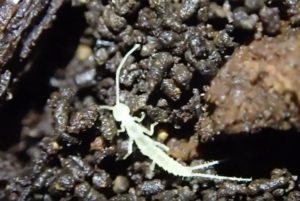
Oilbirds and their big black eyes:

A swiftlet:
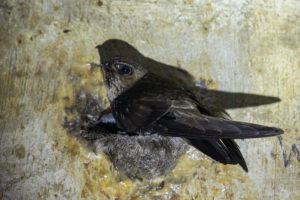
The angel cave fish that can walk on its fins like a salamander walks on its feet:
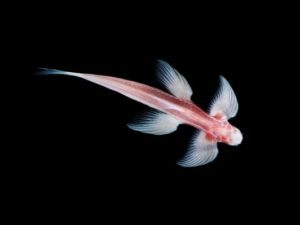
Leptodirus, carrying around some air in its abdomen in case it needs some air:
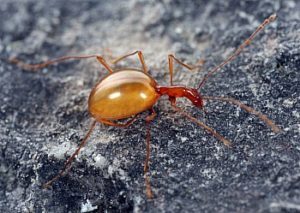
The cave robber spider and its teeny hooked feet:
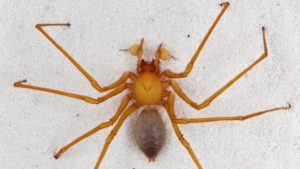
The devils hole pupfish:
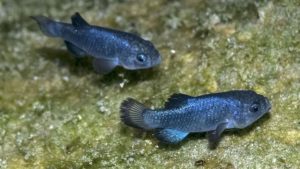
Show transcript:
Welcome to Strange Animals Podcast. I’m your host, Kate Shaw.
Way back in episode 27 we learned about some animals that live deep in caves. Cave dwelling animals are always interesting because of the way they’ve adapted to an unusual environment, so let’s learn about some of them!
We’ll start with an invertebrate. Diplurans are common animals that are related to insects but aren’t insects. They live all over the world, with hundreds of species known to science, but most people have never seen one because of where they live. They like moist, dark areas like soil, dead leaves, and caves. They’re also small, usually only a few millimeters long, although a few species grow larger, up to two inches long, or five cm.
Diplurans have long bodies with a number of segments, six legs, long antennae, and a pair of tail appendages called cerci. Depending on the species, the cerci may just be a pair of straight filaments like an extra pair of antennae, or they may look like pincers. Diplurans with pincer-like cerci use them to help capture prey, while ones with antennae-like cerci eat fungi and plant material.
Diplurans also don’t have eyes. They don’t need eyes because they live underground where there’s little or no light. A lot of species are pale in color or lack pigment completely.
Diplurans have been around for something like 350 million years, although we don’t have very many fossil diplurans. But recently, a new species of dipluran was discovered in North America that has raised some interesting questions.
Vancouver Island is a large island on the west coast of Canada, near the city of Vancouver. It’s prone to earthquakes and contains a lot of caves, and last summer, in June of 2018, a party of cavers and scientists explored two of the caves and found a new dipluran, which has been named Haplocampa wagnelli. This dipluran is chunkier than most other known diplurans, with shorter antennae, which researchers think points to a more primitive body plan. Since the dipluran is so different from most other diplurans known, and because the caves where it was found were under a thick ice sheet until around 18,000 years ago, researchers are trying to figure out if it found its way into the caves after the ice sheet melted or if it survived in the caves while they were buried under ice.
Haplocampa seems to be most closely related to a few diplurans found in Asia. Asia was connected to western North America during the Pleistocene when sea levels were much lower, since so much of the world’s water was frozen, so it’s possible the ancestors of Haplocampa migrated from Asia after the ice sheets started to melt but before the Bering Land Bridge was completely submerged. Possibly its eggs were accidentally transported by birds who foraged in leaf litter where its ancestor lived.
A lot of animals that live in caves are only found in one particular cave system. This happens when a species of animal that lives near a cave moves into the cave, either full-time or part-time. As its descendants grow up, they become more and more adapted to cave life, until eventually they couldn’t live outside of the cave. Since there’s no way for them to travel from one cave system to another, they are confined to that single cave. And since caves are largely difficult for humans to explore, that means there are lots and lots and lots of animals unknown to science living out their quiet lives deep within caves where humans have never visited. Every so often a group of adventurous and brave scientists explore a cave and discover new animals, usually with the help of experienced cavers.
Animals that are endemic to a specific cave system are rare to start with and vulnerable to any changes in the cave environment. The Tumbling Creek cave snail is only found in a single stream in Tumbling Creek Cave in Missouri, in the United States. It lives its whole life in the water and is only about 2 millimeters in size, with a pale yellowish shell. When it was first discovered in 1971 it was common. Thirty years later, researchers could only find about forty of the snails due to water pollution.
Caves aren’t very friendly environments. Most of the animals that live in caves are very small as a result. Lots of insects and spiders live in caves, some snails, lots of fish, lots of crustaceans that live in fresh water, like crawdads and amphipods, and some salamanders. But the only mammals and birds that live in caves leave the cave to hunt or forage outside of it, like bats. There just isn’t enough food inside a typical cave to sustain a population of larger animals.
So what do cave animals eat? Obviously they eat each other, but without plants a cave system is definitely lacking in organic matter that can sustain populations of animals. Nutrients enter a cave primarily in two ways. Water flowing into a cave brings nutrients from outside, and animals that mainly live outside but sleep in caves also bring nutrients in. In the case of animals, their poop is a major source of organic material, with dead animals also contributing to the cave’s ecosystem. Bats in particular support a lot of cave animals with their poop, which is called guano, but bears, hyenas, and various other animals, birds, and insects also spend time in caves, either to sleep or to hibernate, and bring nutrients in from outside in one way or another.
There are two birds that spend time in caves, and I’m going to talk about both of them briefly even though technically they don’t live in caves, because they’re so interesting. Both birds are nocturnal and can echolocate like bats. The oilbird lives in parts of northern South America and is related to nightjars. I have a whole episode planned about nightjars and their relatives, but the oilbird is the only one that echolocates (as far as we know). The other bird that echolocates is the swiftlet.
The oilbird nests in caves and also roosts in caves during the day, then flies out at night and eats fruit. Some oilbirds roost in trees during the day instead. Its wings have evolved to allow it to hover and to navigate through tight areas, which helps it fly through caves. It sees well in darkness, with eyes that are arranged more like those of deep-sea fish rather than typical bird eyes.
Several species of swiflet echolocate. These are the birds that make their nests from saliva, and which humans gather to make bird’s nest soup from. They mostly live in Asia. They nest in caves and roost in caves at night, then fly out during the day to catch insects.
Researchers don’t know a lot yet about either bird’s echolocation. It’s audible to human ears, unlike most bat echolocating, and some researchers think it’s less sophisticated than bats’. It’s always possible there are other birds that echolocate, but we don’t know about them yet because maybe we can’t hear their echolocating.
This is what oilbirds sound like. The clicking noises are the echolocation calls.
[oilbird calls]
Cave fish are especially interesting. There isn’t one kind of cave fish but hundreds, mostly evolved from ordinary fish species that ended up in a cave’s water system and stayed. Sometimes the species of fish that gave rise to cave fish are still around, living outside the cave, but most cave fish species have evolved so much that they’re no longer very closely related to their outside ancestors.
Cave fish are considered extremophiles and they tend to have similar characteristics. They usually have no pigment, no scales, and often have no eyes at all, or tiny eyes that no longer function. They’re usually only a few inches long, or maybe 10 cm, and have low metabolic rates. They typically eat anything they can find.
Some cave fish have evolved in unusual ways to better fit their specific habitats. The cave angel fish lives in a single large cave system in Thailand, in fast-moving water. It’s about an inch long, or not quite 3 cm, and gets its name from its four broad fins, which look feathery like angel wings.
It was discovered in 1985 but it wasn’t until 2016 that researchers verified a persistent rumor about the fish, which is that it can WALK on its fins. It has a robust pelvis and vertebral column, and strong fin muscles that allow it to climb rocks to navigate waterfalls.
Other fish navigate waterfalls and other obstacles by squirming and wriggling, using their fins to push them along. But the cave angel fish walks like a salamander. Scientists are studying the way it walks to learn more about how the ancestors of four-legged animals evolved.
The largest cave dwelling animal is the blind cave eel, which grows up to 16 inches long, or 40 cm, although it’s very slender. Since it appears pink due to a lack of pigment in its skin and it has no eyes or fins, it looks a lot like a really long worm. But it’s actually a fish. Not much is known about it, but it’s widespread throughout western Australia and is sometimes found in wells. It lives in caves or underground waterways that are connected to the ocean.
The first insect that was recognized as living only in caves is a beetle called Leptodirus hochenwartii. It was discovered in 1831 deep in a cave in Slovenia, and researchers of the time found it so intriguing that they invented a whole new discipline to study it and other cave animals, known as biospeleology.
Leptodirus has some interesting adaptations to cave living. It has no wings and no eyes, its antennae and legs are long, but the real surprise is its body. Its head is small and the thorax, the middle section of an insect, is slender. But the abdomen is relatively large and round, and the insect uses it to store moist air. Caves tend to be humid environments and Leptodirus has evolved to need plenty of moisture in the air it breathes. But some parts of a cave can be dry, so not only does Leptodirus keep a supply of breathable air in its abdomen, its antennae can sense humidity levels with a receptor called the Hamann organ.
Some spiders live in caves and like other cave dwellers, they’ve evolved to look strange compared to ordinary spiders. The cave robber spider was only discovered in 2010 in a few caves in Oregon. Researchers suspect there are more species of cave robber spider in other cave systems that haven’t been explored yet by scientists.
The cave robber spider is so different from other spiders that it’s been placed in its own family, Trogloraptoridae, which means cave robber. It has hook-like claws on the ends of its legs which it probably uses to capture prey. It spins small, simple webs on the roofs of caves and researchers think it probably hangs upside down from its web and grabs its prey as it passes by. But since no one knows what the cave robber spider eats, it’s anyone’s guess. Researchers have even tried raising the spider in captivity to learn more about it, but it wouldn’t eat any of the insects or other small invertebrates it was offered as food. It starved to death without ever eating anything, so it’s possible it only eats specific prey. It’s a yellowish-brown spider with two rows of teeth, called serrula in spiders, which researchers say is unique among spiders.
It’s also pretty big for a cave dweller. Its body is up to 10 millimeters long, or about a third of an inch, and it has a legspan of about 3 inches, or 7.6 cm. But it’s very shy and rare, and of course it’s not going to hurt you. It literally wouldn’t even hurt a fly to keep itself from starving.
One of the scientists who discovered the spider and is studying it, Charles Griswold, points out that there are stories in the area of giant spiders living in caves. He suggests the cave robber spider might be the source of the stories, since a three inch spider looks much bigger when it’s hanging down from the roof of a cave right in your face, with hooked claws.
Let’s finish with a remarkable cave fish known as the devil’s hole pupfish. Devil’s hole is a geothermal pool inside a cavern in the Amargosa Desert in Nevada, which is in the southwestern United States. It’s not far from Death Valley. The cavern is more than 500 feet deep, or 150 meters, with water that stays at about 92 degrees Fahrenheit, or 33 degrees Celsius. There’s a single small opening into the cavern at the surface, which geologists estimate opened about 60,000 years ago. The cavern and cave system are more than half a million years old.
The geothermal pool is home to the devils hole pupfish, which is barely an inch long, or 25 millimeters, and looks pretty ordinary. It mostly stays around the opening to the surface, where there’s a limestone shelf just below the water’s surface that measures about 6 ½ by 13 feet, or 2 by 4 meters. While the pupfish does swim deeper into the cavern at times, it mostly eats algae that live on and around the shelf, and tiny animals that live within the algae. It also depends on the shelf for laying eggs and spawning.
So the shelf is really important. But it’s also really small and close to the surface. It can only support so many pupfish, so the average devil’s hole pupfish population is about 200 or 300 fish, although this fluctuates naturally depending on many factors. In the 1960s, a farming corporation drilled wells in the area and pumped water out for irrigation, and the water in devil’s hole started to drop and drop. Devil’s hole is part of Death Valley National Monument, and conservationists were well aware of how fragile the pupfish’s environment was. As the water level dropped, threatening to expose the limestone shelf that the pupfish depended on for their entire lives, conservation groups sued to stop the pumping of groundwater in the area. After a series of court cases that went all the way up to the Supreme Court, the water rights were acknowledged to be part of the national monument status. Pumping of groundwater was limited and the pupfish was saved.
The water level in devil’s hole is monitored daily, which has led to a lot of information about how the water is affected by seismic events. Earthquakes as far away as Alaska, Japan, and South America have all affected the water level.
Researchers aren’t sure how long the pupfish have lived in devil’s hole. Some researchers think they’ve been there for 20,000 years, others think it’s more like a few hundred. Researchers aren’t sure how such a small population of fish has stayed healthy for so long, since such a restricted number of individuals should be so inbred they’re no longer viable. The most recent genetic analysis of the pupfish suggests they became isolated from other pupfish species in the area less than a thousand years ago. But if that’s the case, no one’s sure how they got into devil’s hole in the first place. Flooding of the area hasn’t happened in the last thousand years.
Because the pupfish’s habitat is so fragile, the U.S. Fish and Wildlife Service has moved some of the fish into captive populations that mimic the fish’s original habitat. It’s nice to think that these tiny silvery-blue fish with big eyes have so many people working to keep them safe.
You can find Strange Animals Podcast online at strangeanimalspodcast.com. We’re on Twitter at strangebeasties and have a facebook page at facebook.com/strangeanimalspodcast. If you have questions, comments, or suggestions for future episodes, email us at strangeanimalspodcast@gmail.com. We also have a Patreon if you’d like to support us that way.
Thanks for listening!